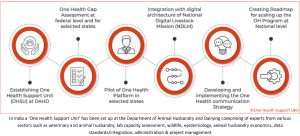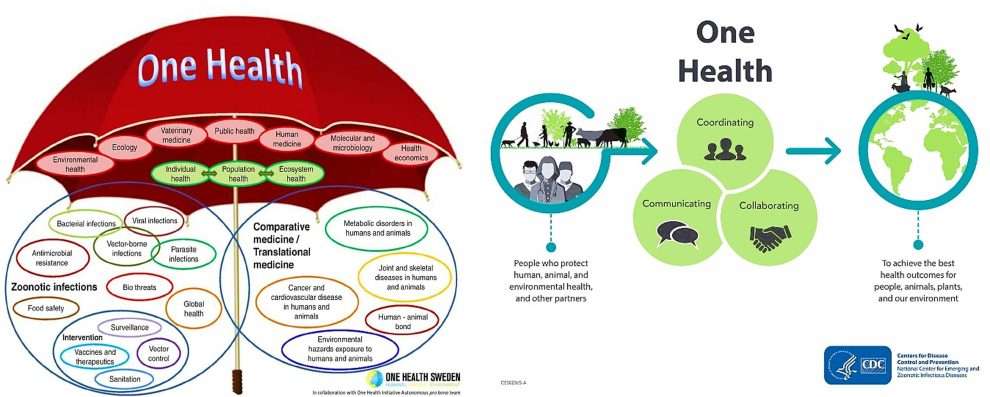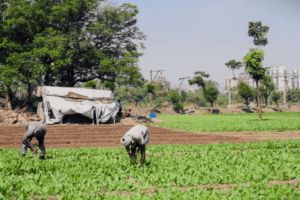The ‘One Health’ approach is about the concept that human, animal and plant health are interdependent and bound to the overall health of the ecosystems in which they exist. Though known for more than a century, its significance is coming to be realized now even more, so it is being emphasized and pursued vigorously world over in recent times for several reasons. Prof. Mandava Venkata Subba Rao shares his views on how One Health can be made a reality in India and South Asia.
THE CONTEXT
The world is increasingly interconnected, and so are the health of humans, animals, and the environment. The intricate dance between human, animal, and environmental health has never been more apparent than in today’s world. The emerging infectious disease (EID) and pandemic threats are increasing globally at the animal-human-environment interface. Earlier several fresh EID outbreaks such as West Nile (WN), Severe Acute Respiratory Syndrome (SARS), Highly Pathogenic Avian Influenza (HPAI-H5N1), and Ebola etc., remind us of the close nexus between human and animal health, and exposed multi-dimensional linkages between wildlife, livestock production systems and global public health. This interconnectedness presents both challenges and opportunities, particularly in the realm of EIDs and zoonotic spillover events, where pathogens jump from animals to humans. This interconnectedness has given rise to a new approach to safeguarding health: ‘One Health’. One Health is a collaborative, multi-sectoral, and transdisciplinary approach that works at the local, regional, national, and global levels with the goal of achieving optimal health outcomes, recognizing the interconnectedness between people, animals, plants, and their shared environment.
This concept recognizes that the health of each is inextricably linked to the health of the other, and that tackling health challenges successfully requires a collaborative approach across sectors. This is where the new approach – One Health – steps in, offering a holistic approach to safeguarding public health, animal health, and the well-being of the entire ecosystem.
IMPORTANCE OF ONE HEALTH IN SOUTH ASIA
In the context of India and South Asia, where densely populated communities share close quarters with diverse wildlife and agricultural landscapes, the need for One Health is particularly acute. This region faces a multitude of health challenges, including neglected tropical diseases, antimicrobial resistance, and a growing burden of zoonotic diseases such as Nipah virus, rabies and brucellosis. The region’s intensive agriculture practices, close human-animal interactions, and fragile ecosystems create a fertile ground for zoonotic spillover events. One Health offers a powerful framework to address these complex challenges. Yet, fragmented governance structures, limited resources, and lack of awareness often pose significant challenges to implementing One Health effectively.
But there’s a glimmer of hope. India and South Asia have taken some initial steps towards adopting One Health principles. Organizations, such as the National Centre for Disease Control (NCDC) and the Indian Council of Medical Research (ICMR), work across human and animal health sectors. Existing initiatives such as the National Centre for One Health, and regional collaborations like the South Asian Network for One Health that foster information sharing and joint efforts, as well as community-driven efforts, are paving the way forward. These initiatives showcase the strengths of One Health: early detection through integrated surveillance, seamless collaboration across sectors, and empowerment of communities to adopt responsible practices.
PRIORITY AREAS THAT DESERVE ATTENTION
In moving forward, several key priority areas deserve attention. These are discussed below.
- Strengthening surveillance and early warning systems: Early detection and outbreak response are crucial for mitigating zoonotic threats. One Health nurtures integrated surveillance systems that monitor animal, human, and environmental health, enabling quicker identification and containment of outbreaks. Integrated surveillance that monitors animal, human, and environmental health simultaneously can nip outbreaks in the bud.
- Promoting intersectoral collaboration: Breaking down silos between human health, animal health, and environmental agencies at all levels is crucial for a unified response.
- Building capacity and workforce development: A skilled workforce is vital for effective One Health implementation. Investing in training programs for veterinarians, public health professionals, and environmental scientists equip them with the knowledge and skills to tackle complex challenges.
- Enhancing research and innovation: Research on zoonotic diseases, diagnostics, and vaccines tailored to the region’s specific needs is crucial. One Health promotes research collaboration and resource sharing, accelerating progress towards effective solutions.
- Community engagement and awareness: Educating and engaging communities on responsible human-animal interactions and zoonotic risks is vital for preventing outbreaks at the source. One Health emphasizes empowering individuals and communities to play an active role in safeguarding their health and the health of their environment.
CURRENT LANDSCAPE AND CHALLENGES
While India and South Asia have made strides in implementing One Health principles, many challenges still remain. These include:
- Resource constraints: Limited funding hampers surveillance, research, and infrastructure development.
- Fragmented governance: Lack of coordination between different sectors hinders effective implementation.
- Lack of awareness: Public understanding of One Health and its benefits is often limited.
Overcoming Challenges
Despite these challenges, there is hope. Enabling factors – political will, private sector engagement, and technological advancements – can accelerate progress and offer promising solutions. Key steps include:
- Increased investment: Prioritizing funding for One Health initiatives is crucial for strengthening surveillance, research, and capacity building.
- Improved coordination: Establishing strong intersectoral collaboration mechanisms at all levels (local, national, regional) is essential.
- Public education and awareness: Raising public awareness on One Health principles and promoting responsible behavior towards animals and the environment is vital.
- Harnessing technology: Utilizing innovative technologies, such as data analytics and artificial intelligence, can enhance surveillance, communication, and outbreak response.
 WAY FORWARD: A CALL TO ACTION
WAY FORWARD: A CALL TO ACTION
One Health is not just a concept, it’s a call to action. Stakeholders across sectors – policymakers, public health professionals, veterinarians, environmental scientists, researchers, and communities – must join hands to advance One Health in India and South Asia. Governments can allocate dedicated funding, foster regional cooperation, and streamline governance structures. Research institutions and universities can prioritize One Health research and education. Private companies can invest in sustainable practices and community outreach programs. And individuals can adopt responsible behaviors towards animals and the environment. Concrete steps include:
- Establishing dedicated One Health units and task forces within governments;
- Developing a unified legal and institutional framework;
- Developing and implementing regional One Health action plans;
- Investing in research and development of One Health tools and technologies;
- Raising awareness through community outreach programs and educational initiatives.
This collaborative approach has the potential to not only safeguard public health but to also let us join hands and work towards a One Health future for all.
Economic Benefits of One Health: Saving Money and Boosting Productivity
Emerging infectious diseases and AMR can cause substantial health repercussions and enormous disruption in economic activity globally. The National Academy of Medicine’s Commission on Global Health Risk Framework (GHRF) calculated the average expected losses from infectious disease crisis to cost $60 billion per year in the 21st century (GHRF commission 2016). The One Health approach offers significant economic benefits across various sectors. According to Harvard economist and former US Treasury Secretary Lawrence Summers, the high pandemic risk makes investments in veterinary and human public health systems “possibly the most productive investments on behalf of mankind”. Some of these benefits are:
Reduced Healthcare Costs
- Prevention of zoonotic diseases: Early control of zoonotic disease is both cost effective and prevents human disease. Zoonotic diseases, transmitted from animals to humans, cause billions in healthcare costs annually. One Health helps prevent and control these diseases, and a study in Thailand estimated that a One Health approach to rabies control saved $35 million over five years.
- Improved antibiotic stewardship: One Health promotes responsible antibiotic use in both humans and animals, slowing the development of antimicrobial resistance (AMR). AMR poses a significant economic threat, with estimates suggesting it could cost the global economy $100 trillion by 2050.
- Enhanced public health preparedness: Early detection and response to emerging infectious diseases through One Health collaboration can prevent outbreaks and pandemics, saving lives and reducing economic losses. The COVID-19 pandemic alone led to trillions of dollars in economic damage globally.
Improved Agricultural Productivity
- Reduced animal diseases: One Health helps control these diseases through improved animal health practices, vaccination campaigns, and biosecurity measures. A study in Ethiopia found that a One Health approach to controlling bovine tuberculosis saved the country $14 million per year.
- Enhanced food safety: One Health promotes safe food production and handling practices throughout the food chain, reducing foodborne illnesses and associated economic losses. The World Health Organization estimates that foodborne illnesses cost the global economy $10 billion annually.
- Improved environmental health: A healthy environment is essential for sustainable agriculture. One Health promotes responsible land use practices and pollution control, which benefit both agricultural productivity and ecosystem health.
Additional Benefits
- Increased tourism revenue: Healthy animals and ecosystems are vital for tourism, which is a major economic driver in many countries. One Health helps protect these resources and ensures a sustainable tourism industry.
- Improved livelihoods for rural communities: Many rural communities rely on agriculture and livestock for their livelihoods. One Health helps these communities improve their incomes and food security.
- Stronger global economy: A healthier world with fewer pandemics and zoonotic diseases leads to a more stable and prosperous global economy.
Investment in One Health is Cost-Effective
While implementing a One Health approach requires initial investment, the long-term economic benefits significantly outweigh the costs. Studies have shown that the return on investment for One Health programs can be as high as 100:1!
ENDNOTE
By embracing One Health as a guiding principle, we can chart a healthier future for ourselves, our animals, and the ecosystems we share. Let us urge our leaders, policymakers, and communities to embrace One Health as a critical strategy for safeguarding our collective health and well-being. It’s not just about preventing pandemic, it’s about building a more resilient and sustainable world for all by contributing to economic development and environmental sustainability in the region. Let’s join hands and make One Health a reality in India and South Asia.
In conclusion, One Health offers a win-win situation for both human and animal health, with significant economic benefits across various sectors. By investing in this approach, we can create a healthier, more sustainable, and prosperous world for all.
Together, we can create a region where humans, animals, and nature thrive in harmony.
 Prof. Mandava Venkata Subba Rao is a former Consultant with the FAO and the World Bank and he also served as Professor and Head at the Department of Microbiology at the Sri Venkateswara Veterinary University, Tirupati, Andhra Pradesh, India. He can be reached at mandava_vs@yahoo.com
Prof. Mandava Venkata Subba Rao is a former Consultant with the FAO and the World Bank and he also served as Professor and Head at the Department of Microbiology at the Sri Venkateswara Veterinary University, Tirupati, Andhra Pradesh, India. He can be reached at mandava_vs@yahoo.com





Happy to see this latest blog post coming from AESA on an issue which impacts we all including animals around us. Human health is closely linked to the health of animals and the health of our shared environment. Today, humans and animals interact more closely than ever before. More than half of all diseases people get are zoonotic, meaning they can spread between animals and humans. In many countries around the world including India & other countries in South Asia One Health is being increasingly discussed at various platforms. In the USA, January is marked as One Health Awareness Month. It’s an opportunity to spread awareness about the interconnected realities of our shared world, and also a chance to build capacities for the One Health approach in individuals and organizations across the globe. Given its such high importance, I congratulate Prof Venkata Mandava Subba Rao for sharing his experienced views and way forward to a Healthier Future for India and South Asia. It was pleasure going through the smooth flow of well conceptualized ideas very systematically. Congratulations to AESA too for publishing such high quality blogs on crucial issues. Happy reading!!
“Congratulations to Prof. M.V.Subba Rao on coming out with a very useful blog on “ One Health “ which is a concern not only for India and south Asia but also for the entire globe. Prof. Subba Rao indicated some of the steps to be followed to achieve health of all which include man, animal, plant and ecosystem. The toughest is to achieve effective collaboration among several institutions.
As pointed out by the author that the fragmented governance structures, limited resources, and lack of awareness often pose significant challenges to implementing OH effectively. Mass scale Public awareness programmes need to be organized and extension professionals have an important role to play in this regard. We need to change the slogan from “If Health is lost something is lost” to “If Health is lost everything is lost”.
As OH is multi-dimensional and involves the participation of several institutions and agencies, the challenges are very formidable and we need to address the challenges from several angles in addition to focusing on infections of zoonotic importance.
It is of paramount importance to recognize the urgency in maintaining the health of the soil, water and air which are nature’s gift to us. The negative impact of the pollution of these three primordial elements on health of man, animal, plant and ecosystem (to which man is primarily responsible) is quite discernible.
The success of OH programme depends upon the extent of political commitment coupled with appropriate resources both human and financial. Although, the GOI has established a road map to combat zoonoses in India way back in 2008, it has allocated budget exclusively for OH programme in 2021.The programme is still in its infancy. Effective implementation of OH programme requires enormous resources and we cannot depend upon govt. funding alone. There is a dire need to raise resources from Philanthropists to support this vital programme.
Thanks to AESA for making this important blog available to us.